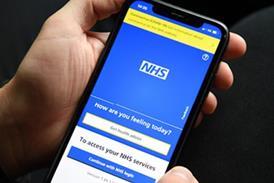An HSJ webinar, held in association with Elsevier, explored the ways in which digital technology might help clinicians make the right decisions for the right patients and at the right time – leading to improved safety and efficiency

When Tim Orchard thinks about the potential of digital technology to support clinicians, he immediately emphasises the sheer scale of the possible opportunities.
“Some of it is just digitising normal workflows. Then there’s an element of changing workflows and allowing technology to aid decision-making. Then there’s a bit about collating data, collecting it, and using it after the event,” suggests Mr Orchard, who is both chief executive and consultant gastroenterologist at Imperial College Healthcare Trust.
“There’s something around accessing data remotely – really helpful if you’re having a conversation with another member of your team about how to manage a patient. That then moves you onto remote monitoring of patients. There’s a bit about digital systems pulling data together from multiple sources to allow clinicians then to make the best possible decisions in real time. You can then move into the realms of AI.”
Sponsored by 
The comments were made at a recent HSJ webinar. Held in association with Elsevier, it was convened to explore the ways in which digital technology might help clinicians make the right decisions for the right patients and at the right time – leading to improved safety and efficiency.
Mr Orchard’s comments were unequivocal: “I think [the potential] is huge: basically everything from the very front door right the way through care and out the other end.”
The question that naturally follows, then, is how best to capitalise on those possible opportunities. James Bird, another panellist during the event, is Imperial College Healthcare Trust’s chief nurse information officer. He emphasised that the technology that is most useful to clinicians will always be that which “fits well inside the workflow”.
“If you’ve got technology that doesn’t create extra work, doesn’t create steps which appear to the clinician to be superfluous or take them off the expected pathway of what the care they were expecting delivers, inevitably it is easier to embed.”
It was a point reinforced by Robert Nieves, vice president of clinical informatics at Elsevier and a registered nurse.
“The key aspect of any technology that’s successful is really how it’s adopted and used by the clinicians, and from that perspective it has to be of value,” he said.
“It needs to provide a value to me as a clinician, not just be about collecting data – which unfortunately many of the systems become, and the clinicians then have a bad taste in their mouths because it is just considered another task, rather than how it can help me as I’m making decisions at the point of care.”
If vendors and in house IT departments are to create helpful systems, then he argued support from clinicians will be crucial. “Clinicians need to take the responsibility on to say: ‘These are our needs,’ and work with informatics team and IT teams to really come up with solutions that really work for them.”
Concluded Mr Orchard: “You have to make it useful to the clinician. That’s the ultimate key here – it has to enhance what the clinician is doing, and I would add into that it needs to provide some sort of analytic function that can play back to the clinician to allow them to understand how they’re doing.”
The free webinar can now be watched here.
Can digital technology help clinicians make safer, more efficient decisions?
- 1
 Currently reading
Currently readingCan digital technology help clinicians make safer, more efficient decisions?
- 2



























